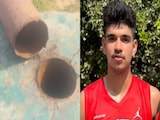- A radioactive wasp nest was found at Savannah River Site during an inspection
- Radiation in the nest was ten times above federal safety limits near nuclear waste tanks
- The nest was destroyed and disposed of as radioactive waste after being sprayed with insecticide
A highly radioactive wasp nest has been discovered at the Savannah River Site, a former Cold War-era nuclear weapons facility in South Carolina. The find was made during a routine inspection on July 3, according to officials from the US Department of Energy (DOE), as reported by CNN.
The nest was located on a post near massive storage tanks containing liquid nuclear waste. Radiation levels in the nest were reportedly ten times higher than the limit allowed by federal safety regulations.
Despite the alarming reading, DOE officials emphasised that the tanks were not leaking and assured the public that there is no current risk to workers or the surrounding community.
Workers at a site destroyed the radioactive wasp nest by initially spraying it with insect killer, and then they carefully removed the nest and threw it away as radioactive waste. During the inspection, no wasps were found.
Officials believe that the nest was contaminated by onsite legacy radioactive contamination. Even though the site is no longer fully active, some radiation still remains in the soil, dust, or surfaces since the time it was fully operational and was making parts for nuclear bombs.
Tom Clements, the executive director of the group, told NBC Connecticut that knowing the type of wasp nest is a must because some wasps build nests from dirt, while others use different materials. This will help them figure out where the radioactive material came from.
In a text message, Mr Clements said, "I'm as mad as a hornet that SRS didn't explain where the radioactive waste came from or if there's some kind of leak from the waste tanks that the public should know about."
The Savannah River Site was opened in the early 1950s during a tension between the US and the Soviet Union. Initially, the site was used to produce plutonium pits, but now it focuses on two major things: producing nuclear fuel and cleaning up the old nuclear waste and contamination left.
According to the Savannah River Mission Completion, the site has created about 625 million litres of liquid nuclear waste. Workers have now been slowly reducing the amount of this waste by using evaporation, and now it is down to about 129 million litres.















